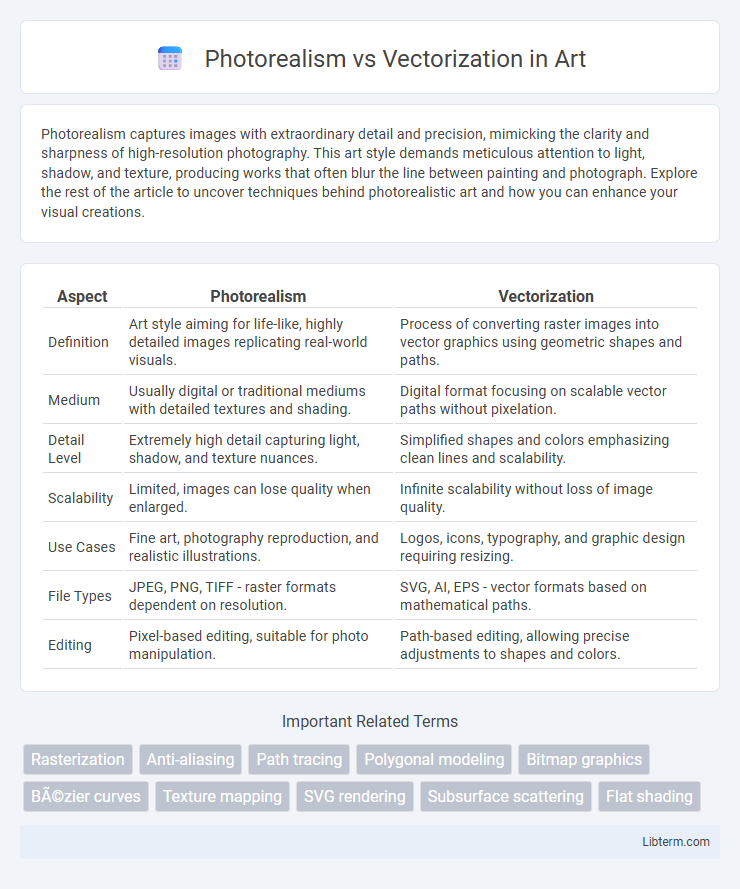Photorealism captures images with extraordinary detail and precision, mimicking the clarity and sharpness of high-resolution photography. This art style demands meticulous attention to light, shadow, and texture, producing works that often blur the line between painting and photograph. Explore the rest of the article to uncover techniques behind photorealistic art and how you can enhance your visual creations.
Table of Comparison
| Aspect | Photorealism | Vectorization |
|---|---|---|
| Definition | Art style aiming for life-like, highly detailed images replicating real-world visuals. | Process of converting raster images into vector graphics using geometric shapes and paths. |
| Medium | Usually digital or traditional mediums with detailed textures and shading. | Digital format focusing on scalable vector paths without pixelation. |
| Detail Level | Extremely high detail capturing light, shadow, and texture nuances. | Simplified shapes and colors emphasizing clean lines and scalability. |
| Scalability | Limited, images can lose quality when enlarged. | Infinite scalability without loss of image quality. |
| Use Cases | Fine art, photography reproduction, and realistic illustrations. | Logos, icons, typography, and graphic design requiring resizing. |
| File Types | JPEG, PNG, TIFF - raster formats dependent on resolution. | SVG, AI, EPS - vector formats based on mathematical paths. |
| Editing | Pixel-based editing, suitable for photo manipulation. | Path-based editing, allowing precise adjustments to shapes and colors. |
Introduction to Photorealism and Vectorization
Photorealism aims to create images that are indistinguishable from high-resolution photographs by emphasizing detailed textures, lighting, and shading effects. Vectorization converts raster images into scalable vector graphics using mathematical paths, enabling infinite resizing without loss of quality. Understanding the contrast between photorealistic detail and the clean, geometric precision of vector images is essential for selecting the appropriate graphic technique for design projects.
Understanding Photorealism: Definition and Characteristics
Photorealism is an art style aiming to replicate real-life images with meticulous detail, emphasizing accurate lighting, texture, and color fidelity to create lifelike representations. It focuses on capturing every minute aspect of a scene, often using techniques like airbrushing or digital rendering to achieve a near-photographic quality. Characteristics of photorealism include clarity, high resolution, and precise shading that mimic the nuances of light and shadow found in actual photographs.
What is Vectorization? Key Concepts Explained
Vectorization is the process of converting raster images, composed of pixels, into vector graphics defined by mathematical paths such as points, lines, and curves. Unlike photorealism, which aims to replicate images with pixel-perfect detail and shading, vectorization focuses on creating scalable, resolution-independent graphics that remain crisp at any size. Key concepts include anchor points, Bezier curves, and path operations, enabling flexible editing and efficient file sizes ideal for logos, illustrations, and digital art.
Artistic Intent: Realism vs. Abstraction
Photorealism emphasizes meticulous detail and optical accuracy to replicate real-world scenes, highlighting artistic intent rooted in realism and precise visual representation. Vectorization, on the other hand, abstracts images into scalable geometric shapes and lines, prioritizing clean, stylized forms over intricate detail. This contrast reflects differing goals: photorealism seeks to immerse viewers through lifelike accuracy, while vectorization embraces abstraction and design flexibility.
Image Creation Techniques: Raster vs. Vector
Photorealism relies on raster image creation techniques that use pixels to capture intricate color gradients and fine details, ideal for lifelike visuals. Vectorization employs mathematical paths and geometric shapes to create scalable images without loss of quality, suited for logos and graphic designs requiring flexibility. Understanding the distinction between raster's pixel-based complexity and vector's resolution-independent scalability is essential for choosing the right image creation method.
Visual Appeal: Detail vs. Simplicity
Photorealism emphasizes intricate details and realistic textures, creating visually rich and immersive images that closely mimic real life. Vectorization prioritizes simplicity and clean lines, resulting in crisp, scalable graphics ideal for logos and icons with minimalistic appeal. The visual appeal of photorealism lies in its complexity and depth, whereas vectorization offers clarity and versatility through abstraction.
Use Cases: When to Choose Photorealism
Photorealism excels in use cases requiring lifelike visuals, such as architectural renderings, product advertising, and virtual reality experiences where accurate lighting and texture details are critical. This approach enhances user engagement in marketing campaigns by providing a true-to-life representation of products or environments. Photorealism is preferred when precise visual communication and emotional impact depend on realistic imagery.
Use Cases: When to Choose Vectorization
Vectorization excels in use cases requiring scalability and crisp, clean graphics such as logos, icons, and technical illustrations, where maintaining sharp edges across various sizes is essential. It is ideal for designs that demand easy editing, color changes, or layering, commonly used in branding, web graphics, and printed materials requiring consistent quality. Vector graphics also perform better in animation and interactive media due to their smaller file sizes and resolution independence compared to photorealistic raster images.
Digital Workflow Differences
Photorealism relies on pixel-based images with intricate details, demanding high-resolution files and extensive processing power for rendering, while vectorization uses mathematical paths to create scalable graphics that maintain clarity at any size. The digital workflow for photorealism involves detailed photo editing, color correction, and texture mapping within raster software like Adobe Photoshop, whereas vectorization requires precise anchor point manipulation and path adjustments in vector programs like Adobe Illustrator. File formats differ significantly, with photorealistic images typically saved as JPEG or PNG and vector graphics saved as SVG or AI, impacting storage, scalability, and compatibility within digital projects.
Future Trends in Photorealism and Vectorization
Future trends in photorealism emphasize enhancing AI-driven rendering techniques to produce hyper-realistic images with computational efficiency, leveraging neural networks and real-time ray tracing. Vectorization is advancing through improved algorithms that enable seamless conversion of complex raster images into scalable, editable vector graphics without quality loss, driven by machine learning and artificial intelligence. The convergence of photorealism and vectorization technologies is poised to transform digital art, graphic design, and multimedia production by enabling richer, more versatile visual content across platforms.
Photorealism Infographic

 libterm.com
libterm.com